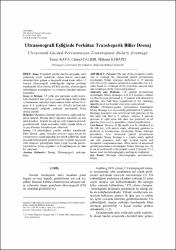Ultrasonografi eşliğinde perkütan transhepatik bilier drenaj
Abstract
Amaç: Prospektif yapıda olan bu çalışmada, safra
yollarında çeşitli nedenlerle oluşan basılar sonucunda
obstrüktif ikter gelişen ve inoperabl olarak kabul edilen 13
hastaya ultrasonografi rehberliğinde yapılan perkütan
transhepatik bilier direnaj (PTBD) işlemini, ultrasonografi
rehberliğinin avantajlarını ve yöntemin tekniğini sunmayı
amaçladık.
Gereç ve Yöntem: 1.5 yıllık süre içerisinde çeşitli nedenlerle
obstrüktif ikter gelişen, inoperabl olarak kabul edilen
ve hastanemiz radyoloji depertmanına refere edilen 13 olguya
8 F ponksiyon kateter seti (Rüsch) kullanılarak
ultrasonografi eşliğinde perkütan transhepatik bilier
direnaj yapıldı.
Bulgular: Olguların tümünde safra direnajı sağlanarak ba-
şarıya ulaşıldı. Direnaj işlemi olguların sekizinde sol ana
safra kanalına , beşinde ise sağ ana safra kanalına girilerek
gerçekleştirildi. İşlem sonrasında hiçbir olguda erken ya
da geç dönemde komplikasyon izlenmedi.
Sonuç: US rehberliğinde yapılan pekütan transhepatik
bilier direnaj , iğneyi istenilen seviyeye uygun bir açı ile
yerleştirmeye olanak sağladığı için tercih edilebilen, işlem
sırasında kolanjiografi gerektirmeyen, iyonizan radyasyon
riski olmayan, gerektiğinde hasta yatağı başında gerçekleştirilebilen,
kolay uygulanır ve komplikasyonu az olan
bir yöntemdir. Purpose: The aim of this prospective study
was to evaluate the ultrasound guided percutaneous
transhepatic biliary drainages performed in 13 patients
with obstructive jaundice accepted as inoperable over a 2-
years based on technique of the procedure, success rates
and advantages of the ultrasound guidance
Materials and Methods: US- guided percutaneous
transhepatic biliary drainages with 8 F puncture catheter
set (Rüsch) were performed in 13 patients with obstructive
jaundice who had been hospitalized in the radiology
department of our hospital over a two years period.
Results: Ultrasound-guided percutaneous transhepatic
biliary drainage was successfully performed in 13 patients.
Drainage procedure was carried out with puncture of the
left main bile duct in 8 patients, whereas 5 patients
puncture of right main bile duct was preferred. In all
patients, there were no procedure- related complications.
Conclusion: Because of the needle can be introduced to
the bile duct with narrow angle, ultrasound guidance is
preferred in percutaneous transhepatic biliary drainage
procedures. Also ultrasound guided percutaneous
transhepatic biliary drainage is a simple, easily applied
and safe procedure with high tecnical results and
acceptable complication rates. Other merits of ultrasound
guided percutaneous transhepatic biliary drainage are; (1)
it can be performed in the patient’s room if desired. (2) it
has no need for cholangiography and has no irradiation.
Source
Afyon Kocatepe Üniversitesi, Kocatepe Tıp DergisiVolume
6Issue
1Collections
- Makaleler [452]



















